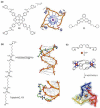New trends for metal complexes with anticancer activity
- PMID: 18155674
- PMCID: PMC2923029
- DOI: 10.1016/j.cbpa.2007.11.013
New trends for metal complexes with anticancer activity
Abstract
Medicinal inorganic chemistry can exploit the unique properties of metal ions for the design of new drugs. This has, for instance, led to the clinical application of chemotherapeutic agents for cancer treatment, such as cisplatin. The use of cisplatin is, however, severely limited by its toxic side-effects. This has spurred chemists to employ different strategies in the development of new metal-based anticancer agents with different mechanisms of action. Recent trends in the field are discussed in this review. These include the more selective delivery and/or activation of cisplatin-related prodrugs and the discovery of new non-covalent interactions with the classical target, DNA. The use of the metal as scaffold rather than reactive centre and the departure from the cisplatin paradigm of activity towards a more targeted, cancer cell-specific approach, a major trend, are discussed as well. All this, together with the observation that some of the new drugs are organometallic complexes, illustrates that exciting times lie ahead for those interested in 'metals in medicine'.
Figures




References
-
-
Hambley TW. Developing new metal-based therapeutics: challenges and opportunities. Dalton Trans. 2007:4929–4937. This recent perspective provides an excellent introduction to the present status of the field of medicinal inorganic chemistry and discusses the difficulties that are currently faced in the development of new metal-based therapeutics
-
-
- Orvig C, Abrams MJ. Medicinal inorganic chemistry: introduction. Chem Rev. 1999;99:2201–2203. - PubMed
-
- Guo Z, Sadler PJ. Metals in Medicine. Angew Chem Int Ed. 1999;38:1512–1531. - PubMed
-
- Thompson KH, Orvig C. Metal complexes in medicinal chemistry: new vistas and challenges in drug design. Dalton Trans. 2006:761–764. - PubMed
-
- Jung Y, Lippard SJ. Direct cellular responses to platinum-induced DNA damage. Chem Rev. 2007;107:1387–1407. - PubMed
Publication types
MeSH terms
Substances
Grants and funding
LinkOut - more resources
Full Text Sources
Other Literature Sources

